

EPSC2015 767. Southwest Research Institute (SwRI) 2015 News Release - SwRI’s Bottke to present AGU Shoemaker Lecture. For immediate release Image Courtesy of Simone Marchi (SwRI), SSERVI, NASA Southwest Research Institute’s Dr.
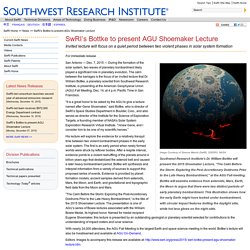
Southwest Research Institute (SwRI) 2015 News Release - SwRI scientists predict that rocky planets formed from ‘pebbles’ For immediate release Boulder — Oct. 26, 2015 — Using a new process in planetary formation modeling, where planets grow from tiny bodies called “pebbles,” Southwest Research Institute scientists can explain why Mars is so much smaller than Earth.
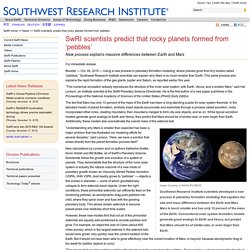
Asteroid Mining Legalisation - Massive Victory or Massive Mistake? - Cosmos Revealed. 51 Degrees North. What did Dawn learn at Vesta? Posted by Emily Lakdawalla Topics: asteroid 4 Vesta, pretty pictures, asteroids, Dawn, explaining science It's now been two years since Dawn wrapped up its work at the second-largest asteroid.
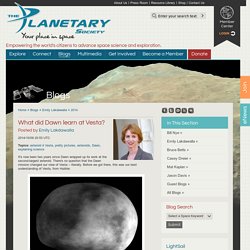
There's no question that the Dawn mission changed our view of Vesta -- literally. Before we got there, this was our best understanding of Vesta, from Hubble: Ben Zellner, Peter Thomas, and NASA. Aa22451-13. GEOPHYSICAL CHARACTERIZATION OF THE CHICXULUB IMPACT CRATER - Gulick - 2013 - Reviews of Geophysics. [2] An extraterrestrial body impacted the Earth in the region that today is the Yucatán Peninsula 65.5 million years ago (Ma), causing worldwide devastation that almost certainly was the principal cause of a mass extinction event [e.g., Alvarez et al., 1980; Hildebrand et al., 1991; Schulte et al., 2010].
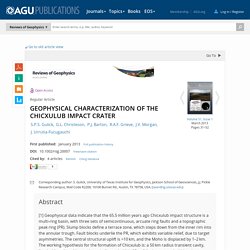
Initial evidence for the impact was found at Cretaceous-Paleogene boundary (K-Pg) deposits around the world. . [3] Over a decade after the impact hypothesis was introduced, the Chicxulub impact crater (Figure 1) was identified in México, based on gravity and magnetic data and drilling results [Hildebrand et al., 1991; Sharpton et al., 1992; Camargo-Zanoguera and Suarez-Reynoso, 1994; Pope et al., 1996; Sharpton et al., 1996]. Subsequently, seismic reflection and refraction data were acquired within and across the crater in 1996 and again in 2005 (Figure 2) . [6] The Chicxulub impact structure, México, is unique. 2 Data and Methods 2.1 Seismic Data 2.2 Potential Field Data. Hal's Talks. Index.htmlAlessandro MorbidelliAlessandro MorbidelliAlessandro Morbidelli. Alessandro Morbidelli Born in Italy on May, 2, 1966Nationality Italian Professional addressObservatory of NiceB.P. 4229, 06304 Nice Cedex 4TEL: 33-4-92003051E-MAIL: morby@obs-nice.fr Education*Master degree in Physics at the University of Milan (Italy) - 1988*Ph.

D. in Mathematics at the University FUNDP of Namur (Belgium) - 1991 ProfessionTitle: Researcher in Astronomy (permanent position)Institution: C.N.R.S. -- Conseil National de la Rescherche ScientifiqueLaboratory:Departement Cassiopee,Observatoire de la Cote d'Azur, Nice, France. The origin and emergence of life under impact bombardment. Did dinosaur-killing asteroid trigger largest lava flows on Earth? The asteroid that slammed into the ocean off Mexico 66 million years ago and killed off the dinosaurs probably rang the Earth like a bell, triggering volcanic eruptions around the globe that may have contributed to the devastation, according to a team of UC Berkeley geophysicists.
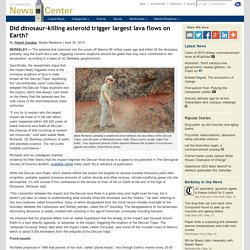
Fresh evidence for how water reached earth found in asteroid debris. Quantity of water on Earth not unique Water likely reached Earth via comets and asteroids crashing into Earth’s surface Evidence found in the atmosphere of white dwarf star Asteroid found to contain 30-35% Earth’s water content Research led by the University of Warwick and published by Royal Astronomical Society Water delivery via asteroids or comets is likely taking place in many other planetary systems, just as it happened on Earth, new research strongly suggests.
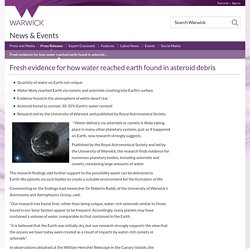
Published by the Royal Astronomical Society and led by the University of Warwick, the research finds evidence for numerous planetary bodies, including asteroids and comets, containing large amounts of water. The research findings add further support to the possibility water can be delivered to Earth-like planets via such bodies to create a suitable environment for the formation of life. Commenting on the findings lead researcher Dr Roberto Raddi, of the University of Warwick’s Astronomy and Astrophysics Group, said: 7th May 2015. The Sculptured Hills of the Taurus Highlands: Implications for the relative age of Serenitatis, basin chronologies and the cratering history of the Moon - Spudis - 2011 - Journal of Geophysical Research: Planets (1991–2012)
Abstract [1] New images from the Lunar Reconnaissance Orbiter Camera show the distribution and geological relations of the Sculptured Hills, a geological unit widespread in the highlands between the Serenitatis and Crisium basins.
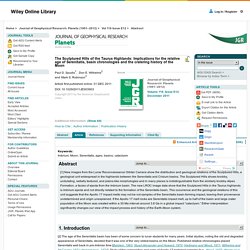
USGS Astrogeology Science Center. Meteor Crater is a 180 m deep, 1.2 km diameter bowl-shaped depression located in Northern Arizona, near the southern edge of the Colorado Plateau.
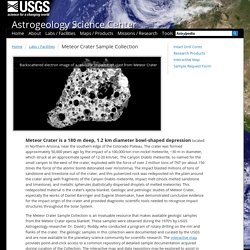
The crater was formed approximately 50,000 years ago by the impact of a 100,000-ton iron-nickel meteorite, ~30 m in diameter, which struck at an approximate speed of 12-20 km/sec. The Canyon Diablo meteorite, so named for the small canyon to the west of the crater, exploded with the force of over 2 million tons of TNT (or about 150 times the force of the atomic bomb detonated over Hiroshima). The impact blasted millions of tons of sandstone and limestone out of the crater, and this pulverized rock was redeposited on the plain around the crater along with fragments of the Canyon Diablo meteorite, impact melt (shock-melted sandstone and limestone), and metallic spherules (ballistically dispersed droplets of melted meteorite). This redeposited material is the crater’s ejecta blanket. Rosetta's target: comet 67P/Churyumov-Gerasimenko.
There are hundreds of comets flying around the Solar System, each of them a potential target for ESA's comet-chasing Rosetta mission.

As the mission took shape, the science team was faced with the difficult task of sifting through these candidates until they identified a handful of suitable objects. Of particular interest were comets that had been observed over at least several orbits of the Sun, and which were known to be fairly active. Ideally, they had to follow orbital paths near the ecliptic plane, so that a rendezvous, prolonged survey and landing would be easier to achieve.
Meteor Crater Helps Unlock Planetary History. The Barringer meteorite crater — known popularly as "Meteor Crater" — near Winslow, Ariz., was formed some 50,000 years ago in the flat-lying sedimentary rocks of the Southern Colorado Plateau in Arizona. Now, scientists are using the crater to study mysteries near and far. This out-of-the-blue geological feature is considered a prime example of a young, well-preserved and well-documented simple impact crater. That means it represents one of the most common morphological features on planetary surfaces, both on Earth, and elsewhere in our solar system. Rosetta's target: comet 67P/Churyumov-Gerasimenko. How to Tell the Size of an Asteroid. Asteroids_by_size_and_number. [Observatoire de la Côte d’Azur] Quand Jupiter était à la place de Mars ! Voir le communiqué de presse INSU Pourquoi Mars est si petite par rapport à la Terre ?
Les deux planètes sont pourtant très voisines dans le Système Solaire interne. Les planètes se formant dans une même région ne devraient-elles pas être semblables (comme c’est le cas de la Terre et de Vénus) ? Un article publié dans le journal Nature le 5 Juin 2011, par K. Walsh et A. Les simulations du processus d’accrétion des planètes rocheuses dans la Système Solaire interne (Mercure, Vénus, la Terre et Mars) ont progressé d’une façon drastique durant la dernière décennie. « Les planètes synthétiques produites dans les expériences numériques avaient des propriétés fidèles à celles des planètes réelles, à une exception majeure près : les modèles produisaient une version de la planète Mars qui était toujours trop massive. », explique S. La grande Virée de bord Ainsi, la ceinture d’astéroïde, qui était a priori un soucis majeur dans ce scénario, s’avère le renforcer !
Contact chercheur : A. Untitled. Asteroid Discoveries Surge by 42 Percent in 2014. Sign In. Sign In. Chambers_binary.pdf. Chambers_exoplanets.pdf. Earth.pdf. Chambers_binary.pdf. 1206.0738v1.pdf. 0610905.pdf. 1311.6816.pdf. Asteroids: Breaking up is hard to do. © NASA/JHUAPLThis image, taken by NASA's Near Earth Asteroid Rendezvous mission in 2000, shows a close-up view of Eros, an asteroid with an orbit that takes it somewhat close to Earth. A new paper argues that the major cause of fragmentation for small asteroids, around one hundred meters in size, is not collisions with other asteroids but rapid rotation induced by radiation. Revista mexicana de ciencias geológicas - Fracturamiento y deformación en el cráter de Chicxulub - Análisis de traza compleja de atributos sísmicos instantáneos.
Sección especial. Chicxulub Crater - Chicxulub Impact. The asteroid or comet whose collision with Earth is thought to have killed off the dinosaurs kicked up a monumental mess in its wake. It is believed that in one second the 10-kilometre-wide body dug a hole 13 kilometres deep. The impact created an explosion equal to that caused by 100 million megatons of TNT - something like 500,000 times the size of the largest nuclear bomb ever set off, the Tsar Bomba. The collision would have produced shock waves with a pressure of about 660 gigapascals, a pressure greater than that in the centre of Earth. The collision has been dated to about 65 million years ago, a time when the dinosaurs as well as many other groups of animal inexplicably died in massive numbers. Fresh Craters on the Moon and Earth. Meteors that are large enough to survive the trip through the Earth’s atmosphere are usually completely destroyed during impact.
Those meteorites that hit on land leave behind an impact crater. On Earth, wind, water, and vegetation rapidly (on geologic times scales) erase craters. With few exceptions, even the largest craters are eventually destroyed by the processes of plate tectonics. On the Moon, however, craters are virtually permanent. GEOPHYSICAL CHARACTERIZATION OF THE CHICXULUB IMPACT CRATER - Gulick - 2013 - Reviews of Geophysics. Gail Christeson's Publications. Christeson, G. L., H. J. A. Van Avendonk, I.
Catalog Page for PIA03379. Trans-Neptunian objects suggest that there are more planets in the solar system. There could be at least two unknown planets hidden well beyond Pluto, whose gravitational influence determines the orbits and strange distribution of objects observed beyond Neptune. Did a massive asteroid impact spark life on Earth? Researchers have recreated a split-second impact of a meteor with primordial Earth, and shown how the 3.5-megaton collision might have reorganized common molecules into some of the early building blocks that led to all life.
The feigned cataclysm took place in a lab in Prague, Czech Republic, using a 492-foot laser system to create a high-density plasma, with temperatures soaring to about 7,640 degrees Fahrenheit, and see its effects on a pool of formamide. That chemical, commonly used in making sulfa drugs, has been identified in the tail of comets and around young stars, and some researchers believe it could have been present on the early Earth nearly 4 billion years ago.
Earth’s water probably didn’t come from comets, Rosetta data suggests.